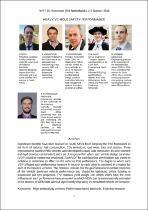JavaScript is disabled for your browser. Some features of this site may not work without it.
- ResearchSpace
- →
- Research Publications/Outputs
- →
- Conference Publications
- →
- View Item
| dc.contributor.author |
Deiss, J

|
|
| dc.contributor.author |
Kienhöfer, F

|
|
| dc.contributor.author |
Nordengen, Paul A

|
|
| dc.contributor.author |
De Saxe, Christopher C

|
|
| dc.contributor.author |
Berman, Robert J

|
|
| dc.contributor.author |
Steenkamp, Anton J

|
|
| dc.date.accessioned | 2019-01-16T11:15:22Z | |
| dc.date.available | 2019-01-16T11:15:22Z | |
| dc.date.issued | 2018-10 | |
| dc.identifier.citation | Deiss, J. et al. 2018. Heavy vehicle safety performance. 15th International Symposium on Heavy Vehicle Transport Technology (HVTT15), Rotterdam, 2 -5 October 2018 | en_US |
| dc.identifier.uri | http://road-transport-technology.org//Proceedings/HVTT%2015//Deiss%20-%20HEAVY%20VEHICLE%20SAFETY%20PERFORMANCE.pdf | |
| dc.identifier.uri | http://www.hvtt15.com/ | |
| dc.identifier.uri | http://hdl.handle.net/10204/10615 | |
| dc.description | Paper presented at the 15th International Symposium on Heavy Vehicle Transport Technology (HVTT15), Rotterdam, 2 -5 October 2018 | en_US |
| dc.description.abstract | Significant benefits have been realised in South Africa from adopting the PBS framework in the form of reduced fuel consumption, CO2 emissions, road wear, trips and crashes. Three representative baseline PBS vehicles were developed (a quad-axle semitrailer, tri-axle interlink and rigid drawbar combination) and a set of ranges within which each vehicle design parameter (VDP) could be varied was developed. Each VDP for each baseline combination was varied in isolation to determine its effect on the vehicles PBS performance. The degree to which each VDP affected each performance measure in relation to each other is presented in a matrix for each of the baseline vehicles. The matrices indicate that the geometrical and inertial properties of the vehicle dominate vehicle performance and should be optimised before looking at suspension and tyre properties. The matrices yield insight into which VDPs have the most influence on each performance measure as well as which VDPs can be conservatively estimated in the absence of OEM data without significantly degrading the simulated vehicle performance. | en_US |
| dc.language.iso | en | en_US |
| dc.relation.ispartofseries | Worklist;21827 | |
| dc.subject | High productivity vehicles | en_US |
| dc.subject | Performance based standards | en_US |
| dc.subject | Technical research | en_US |
| dc.title | Heavy vehicle safety performance | en_US |
| dc.type | Conference Presentation | en_US |
| dc.identifier.apacitation | Deiss, J., Kienhöfer, F., Nordengen, P. A., De Saxe, C. C., Berman, R. J., & Steenkamp, A. J. (2018). Heavy vehicle safety performance. http://hdl.handle.net/10204/10615 | en_ZA |
| dc.identifier.chicagocitation | Deiss, J, F Kienhöfer, Paul A Nordengen, Christopher C De Saxe, Robert J Berman, and Anton J Steenkamp. "Heavy vehicle safety performance." (2018): http://hdl.handle.net/10204/10615 | en_ZA |
| dc.identifier.vancouvercitation | Deiss J, Kienhöfer F, Nordengen PA, De Saxe CC, Berman RJ, Steenkamp AJ, Heavy vehicle safety performance; 2018. http://hdl.handle.net/10204/10615 . | en_ZA |
| dc.identifier.ris | TY - Conference Presentation AU - Deiss, J AU - Kienhöfer, F AU - Nordengen, Paul A AU - De Saxe, Christopher C AU - Berman, Robert J AU - Steenkamp, Anton J AB - Significant benefits have been realised in South Africa from adopting the PBS framework in the form of reduced fuel consumption, CO2 emissions, road wear, trips and crashes. Three representative baseline PBS vehicles were developed (a quad-axle semitrailer, tri-axle interlink and rigid drawbar combination) and a set of ranges within which each vehicle design parameter (VDP) could be varied was developed. Each VDP for each baseline combination was varied in isolation to determine its effect on the vehicles PBS performance. The degree to which each VDP affected each performance measure in relation to each other is presented in a matrix for each of the baseline vehicles. The matrices indicate that the geometrical and inertial properties of the vehicle dominate vehicle performance and should be optimised before looking at suspension and tyre properties. The matrices yield insight into which VDPs have the most influence on each performance measure as well as which VDPs can be conservatively estimated in the absence of OEM data without significantly degrading the simulated vehicle performance. DA - 2018-10 DB - ResearchSpace DP - CSIR KW - High productivity vehicles KW - Performance based standards KW - Technical research LK - https://researchspace.csir.co.za PY - 2018 T1 - Heavy vehicle safety performance TI - Heavy vehicle safety performance UR - http://hdl.handle.net/10204/10615 ER - | en_ZA |






